Applying Machine Learning and Automatic Speech Recognition for Intelligent Evaluation of Coal Failure Probability under Uniaxial Compression
Abstract
:1. Introduction
2. Data and Methods
2.1. Dataset
2.2. Generalized Procedure for AIEFPC Model
2.2.1. AE Sample Segmentation
2.2.2. Sample Feature Extraction and Labeling
2.2.3. Applying AIEFPC
2.3. Automatic Speech Recognition for AE Feature Extraction
2.4. Machine Learning for AIEFPC Model Training
2.5. Parameter Setting
2.6. Evaluation of Model Performance
3. Experiment and Samples
3.1. Experiment Facilities
3.2. Specimen and AE Samples
4. Results and Interpretation
4.1. Correlation of Mel-Frequency Cepstrum Coefficients for Acoustic Emissions and Coal Specimen Stress State
4.2. Prediction of Failure Probability of Coal Using AIEFPC
4.2.1. Characteristics of AIEFPC
4.2.2. Validation of Prediction Effect of AIEFPC
4.3. Probability of AE Samples Predicted as Dangerous Samples by AIEFPC
5. Discussion
5.1. Influence of Sample Feature Selection on the Prediction Accuracy of AIEFPC
5.1.1. Accuracy of AIEFPC with Different Combinations of MFCC as Sample Feature
5.1.2. AIEFPC Prediction Results with Traditional Acoustic Emission Parameters as Sample Features
5.2. Influence of Category Weight of Sample on AIEFPC Prediction Effect on the Different Category Sample Set
6. Conclusions
- AIEFPC based on ASR and ML can predict the AE sample label based on the MFCC of the 40 ms AE segment at any time. The maximum prediction accuracy is 92.0%, while the minimum value is 85.2%.
- The mean value of MFCC-n of non-hazardous samples, hazardous samples, and all samples and the feature parameters wn of AIEFPC can be used to calculate the sample feature importance.
- In the process of using the ML to construct AIEFPC, the sample contains multiple sample features with high importance, which is a critical factor in determining the predictive effect of the AIEFPC.
- When the sample contains the features with high importance, adding features with a low correlation with the stress state has little impact on the prediction results of AIEFPC constructed by ML and ASR. In this paper, all of the first 12 Mel-frequency cepstrum coefficients were selected as sample features.
- When using cumulative hits, cumulative count, and amplitude as sample features, AIEFPC has low prediction accuracy on the hazardous sample set. The MFCC is better than cumulative hits, cumulative count, and amplitude as sample features.
- As the category weight of the hazardous samples increases, the ACC of AIEFPC first increases, followed by a decrease. The accuracy of the safe sample set of AIEFPC decreases as the category weight of the hazardous samples increases.
Author Contributions
Funding
Conflicts of Interest
References
- Yong, I.; Rangang, Y.; Yin, Z.; Xinbo, Z. Application of Acoustic Emission Characteristics in Damage Identification and Quantitative Evaluation of Limestone. Adv. Eng. Sci. 2020, 52, 115–122. [Google Scholar]
- Guangcai, W.; Jiangong, L.; Yinhui, Z.; Guichun, L. Preliminary study on the application conditions of acoustic emission monitoring dynamic disasters in coal and rock. J. China Coal Soc. 2011, 36, 278–282. [Google Scholar]
- He, S.; Song, D.; Li, Z.; He, X.; Chen, J.; Li, D.; Tian, X. Precursor of Spatio-temporal Evolution Law of MS and AE Activities for Rock Burst Warning in Steeply Inclined and Extremely Thick Coal Seams under Caving Mining Conditions. Rock Mech. Rock Eng. 2019, 52, 2415–2435. [Google Scholar] [CrossRef]
- Wang, C. Identification of early-warning key point for rockmass instability using acoustic emission/microseismic activity monitoring. Int. J. Rock Mech. Min. 2014, 71, 171–175. [Google Scholar] [CrossRef]
- Vilhelm, J.; Rudajev, V.; Ponomarev, A.V.; Smirnov, V.B.; Lokajíček, T. Statistical study of acoustic emissions generated during the controlled deformation of migmatite specimens. Int. J. Rock Mech. Min. 2017, 100, 83–89. [Google Scholar] [CrossRef]
- Gong, Y.; Song, Z.; He, M.; Gong, W.; Ren, F. Precursory waves and eigenfrequencies identified from acoustic emission data based on Singular Spectrum Analysis and laboratory rock-burst experiments. Int. J. Rock Mech. Min. 2017, 91, 155–169. [Google Scholar] [CrossRef]
- Ohno, K.; Ohtsu, M. Crack classification in concrete based on acoustic emission. Constr. Build. Mater. 2010, 24, 2339–2346. [Google Scholar] [CrossRef]
- Liu, Y.; Liu, S.; Li, Z.; Li, X.; Chen, P.; Yang, X. Energy distribution and fractal characterization of acoustic emission (AE) during coal deformation and fracturing. Measurement 2019, 136, 122–131. [Google Scholar] [CrossRef]
- Zeng, W.; Yang, S.; Tian, W. Experimental and numerical investigation of brittle sandstone specimens containing different shapes of holes under uniaxial compression. Eng. Fract. Mech. 2018, 200, 430–450. [Google Scholar] [CrossRef]
- Zhang, Y.; Zhao, G.; Li, Q. Acoustic emission uncovers thermal damage evolution of rock. Int. J. Rock Mech. Min. 2020, 132, 104388. [Google Scholar] [CrossRef]
- Zhao, K.; Yang, D.; Gong, C.; Zhuo, Y.; Wang, X.; Zhong, W. Evaluation of internal microcrack evolution in red sandstone based on time–frequency domain characteristics of acoustic emission signals. Constr. Build. Mater. 2020, 260, 120435. [Google Scholar] [CrossRef]
- Gu, Q.; Ma, Q.; Tan, Y.; Jia, Z.; Zhao, Z.; Huang, D. Acoustic emission characteristics and damage model of cement mortar under uniaxial compression. Constr. Build. Mater. 2019, 213, 377–385. [Google Scholar] [CrossRef]
- Geng, J.; Sun, Q.; Zhang, Y.; Cao, L.; Zhang, W. Studying the dynamic damage failure of concrete based on acoustic emission. Constr. Build. Mater. 2017, 149, 9–16. [Google Scholar] [CrossRef]
- Zhou, D.; Zhang, G.; Wang, Y.; Xing, Y. Experimental investigation on fracture propagation modes in supercritical carbon dioxide fracturing using acoustic emission monitoring. Int. J. Rock Mech. Min. 2018, 110, 111–119. [Google Scholar] [CrossRef]
- Zhu, X.; Xu, Q.; Zhou, J.; Tang, M. Experimental study of infrasonic signal generation during rock fracture under uniaxial compression. Int. J. Rock Mech. Min. 2013, 60, 37–46. [Google Scholar] [CrossRef]
- Zhu, Q.; Li, D.; Han, Z.; Li, X.; Zhou, Z. Mechanical properties and fracture evolution of sandstone specimens containing different inclusions under uniaxial compression. Int. J. Rock Mech. Min. 2019, 115, 33–47. [Google Scholar] [CrossRef]
- Li, J.; Hu, Q.; Yu, M.; Li, X.; Hu, J.; Yang, H. Acoustic emission monitoring technology for coal and gas outburst. Energy Sci. Eng. 2019, 7, 443–456. [Google Scholar] [CrossRef] [Green Version]
- Gupta, V.; Juyal, S.; Hu, Y.C. Understanding human emotions through speech spectrograms using deep neural network. J. Supercomput. 2022, 78, 6944–6973. [Google Scholar] [CrossRef]
- Ganne, P.; Vervoort, A.; Wevers, M. Quantification of pre-peak brittle damage: Correlation between acoustic emission and observed micro-fracturing. Int. J. Rock Mech. Min. 2007, 44, 720–729. [Google Scholar] [CrossRef]
- Jiang, D.; Xie, K.; Chen, J.; Zhang, S.; Tiedeu, W.N.; Xiao, Y.; Jiang, X. Experimental Analysis of Sandstone Under Uniaxial Cyclic Loading Through Acoustic Emission Statistics. Pure Appl. Geophys. 2019, 176, 265–277. [Google Scholar] [CrossRef]
- Tirumala, S.S.; Shahamiri, S.R.; Garhwal, A.S.; Wang, R. Speaker identification features extraction methods: A systematic review. Expert. Syst. Appl. 2017, 90, 250–271. [Google Scholar] [CrossRef]
- Randall, R.B.; Antoni, J.; Smith, W.A. A survey of the application of the cepstrum to structural modal analysis. Mech. Syst. Signal Process. 2019, 118, 716–741. [Google Scholar] [CrossRef]
- Randall, R.B. A history of cepstrum analysis and its application to mechanical problems. Mech. Syst. Signal Process. 2017, 97, 3–19. [Google Scholar] [CrossRef]
- Honglei, W.; Song, D.; Xueqiu, H.; Zhenlei, L.; Liming, Q.; Shirui, L. Acoustic Emission characteristics of coal failure using Automatic Speech Recognition methodology analysis. Int. J. Rock Mech. Min. 2020, 136, 104472. [Google Scholar]
- Pu, Y.; Apel, D.B.; Wei, C. Applying Machine Learning Approaches to Evaluating Rockburst Liability: A Comparation of Generative and Discriminative Models. Pure Appl. Geophys. 2019, 176, 4503–4517. [Google Scholar] [CrossRef]
- Sun, D.; Wen, H.; Wang, D.; Xu, J. A random forest model of landslide susceptibility mapping based on hyperparameter optimization using Bayes algorithm. Geomorphology 2020, 362, 107201. [Google Scholar] [CrossRef]
- Suman, A.; Kumar, C.; Suman, P. Early detection of mechanical malfunctions in vehicles using sound signal processing. Appl. Acoust. 2022, 188, 108578. [Google Scholar] [CrossRef]
- Ohlmacher, G.C.; Davis, J.C. Using multiple logistic regression and GIS technology to predict landslide hazard in northeast Kansas, USA. Eng. Geol. 2003, 69, 331–343. [Google Scholar] [CrossRef]
- Li, Z.; Wang, E.; Ou, J.; Liu, Z. Hazard evaluation of coal and gas outbursts in a coal-mine roadway based on logistic regression model. Int. J. Rock Mech. Min. 2015, 80, 185–195. [Google Scholar] [CrossRef]
- Cao, D.; Gao, X.; Gao, L. An Improved Endpoint Detection Algorithm Based on MFCC Cosine Value. Wirel. Pers. Commun. 2017, 95, 2073–2090. [Google Scholar] [CrossRef]
- Zhihua, Z. Machine Learning; Tsinghua University Press: Beijing, China, 2016. [Google Scholar]
- Hang, L. Statistical Learning Method; Tsinghua University Press: Beijing, China, 2012. [Google Scholar]
- Pedregosa, F.; Varoquaux, G.; Gramfort, A.; Michel, V.; Thirion, B.; Grisel, O.; Blondel, M.; Prettenhofer, P.; Weiss, R.; Dubourg, V.; et al. Scikit-learn: Machine Learning in Python. J. Mach. Learn. Res. 2011, 12, 2825–2830. [Google Scholar]
- Zhang, H.; Li, R.; Cai, Z.; Gu, Z.; Heidari, A.A.; Wang, M.; Chen, H.; Chen, M. Advanced orthogonal moth flame optimization with Broyden–Fletcher–Goldfarb–Shanno algorithm: Framework and real-world problems. Expert. Syst. Appl. 2020, 159, 113617. [Google Scholar] [CrossRef]
- Ciyou, Z.; Byrd, R.H.; Lu, P.; Nocedal, J. Algorithm 778: L-BFGS-B: Fortran Subroutines for Large-Scale Bound-Constrained Optimization. Trans. Math. Softw. 1997, 23, 550–560. [Google Scholar]
- Qi, C.; Fourie, A.; Du, X.; Tang, X. Prediction of open stope hangingwall stability using random forests. Nat. Hazards 2018, 92, 1179–1197. [Google Scholar] [CrossRef]
- Xue, Y.; Bai, C.; Qiu, D.; Kong, F.; Li, Z. Predicting rockburst with database using particle swarm optimization and extreme learning machine. Tunn. Undergr. Space Technol. 2020, 98, 103287. [Google Scholar] [CrossRef]
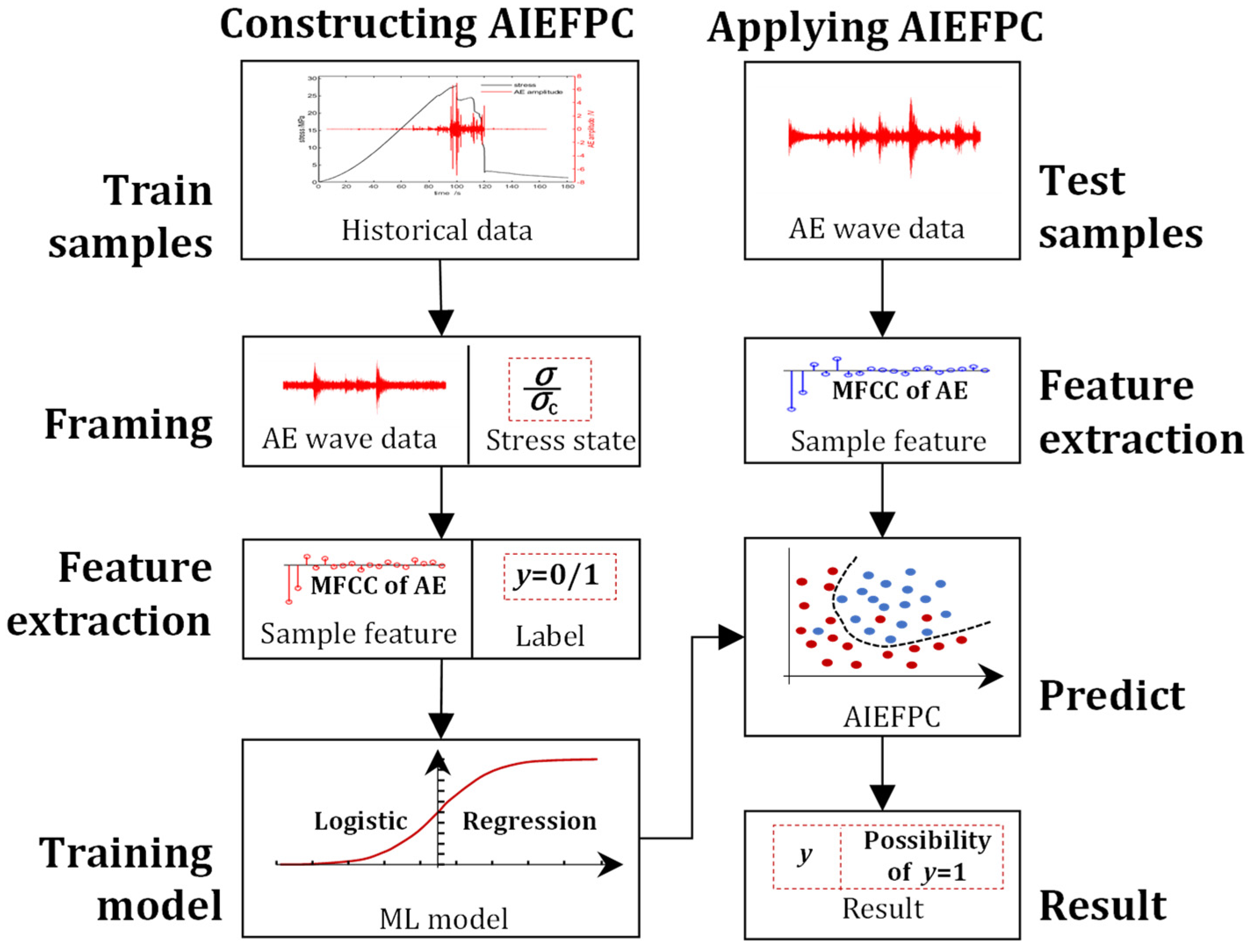
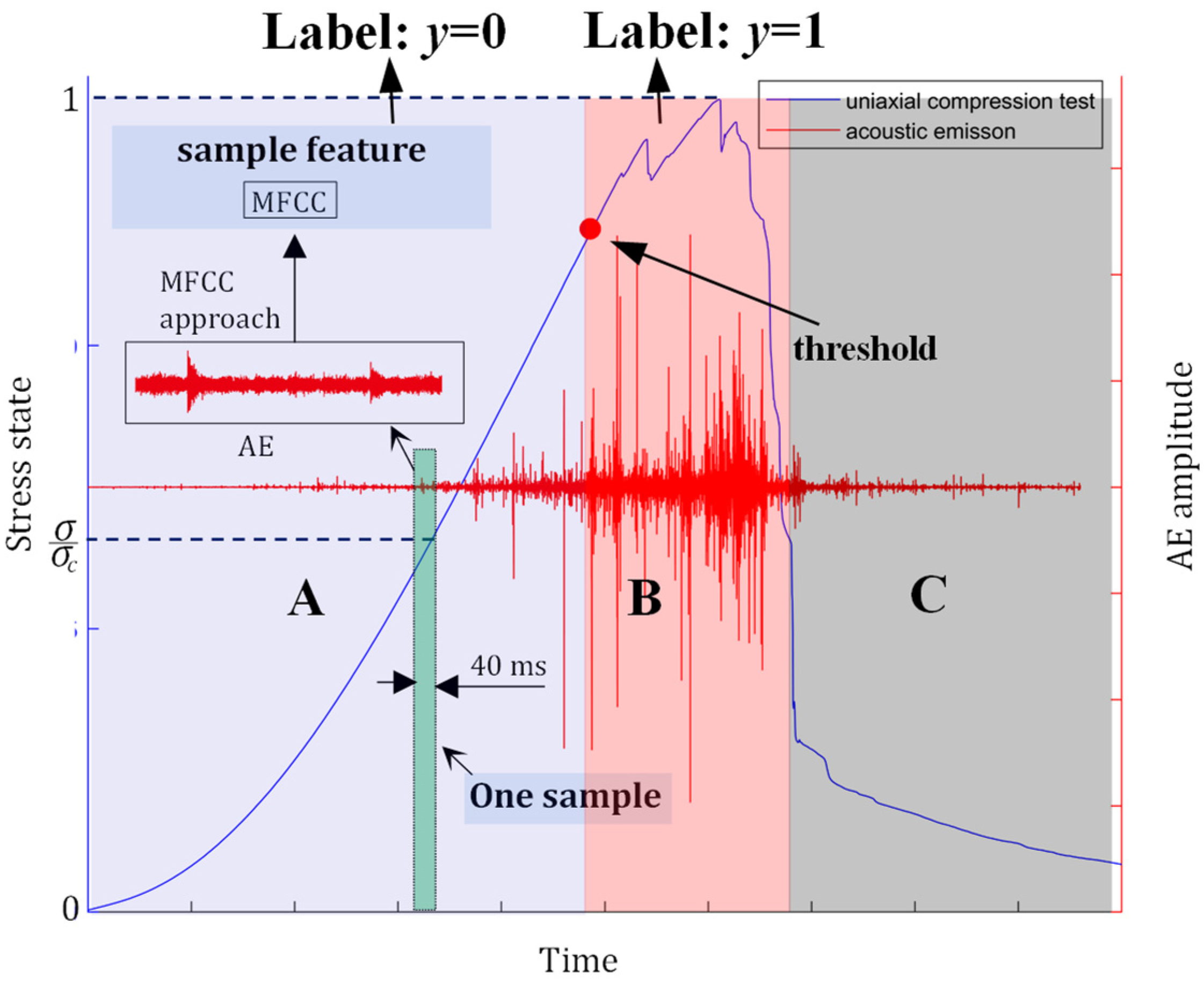


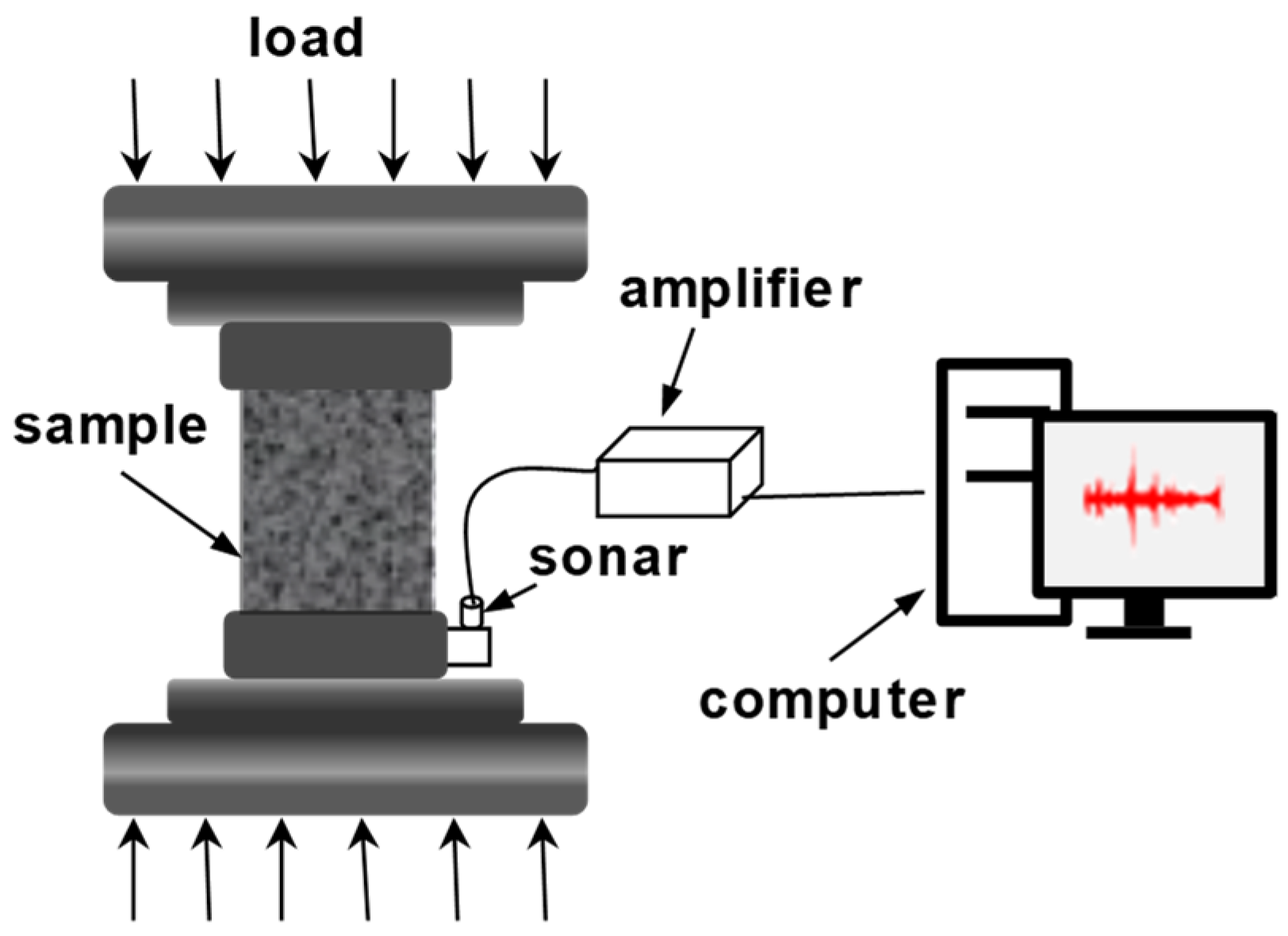
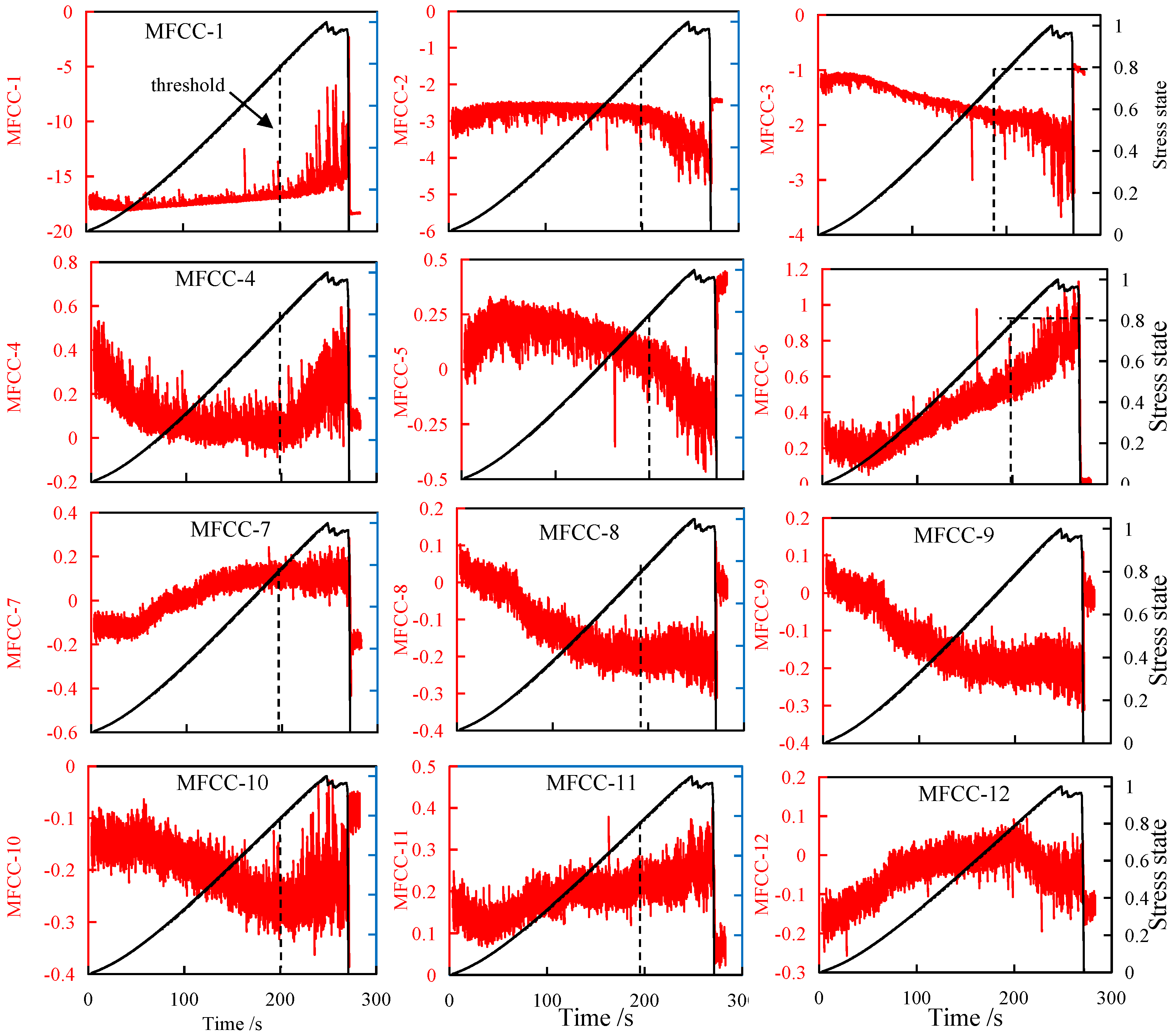
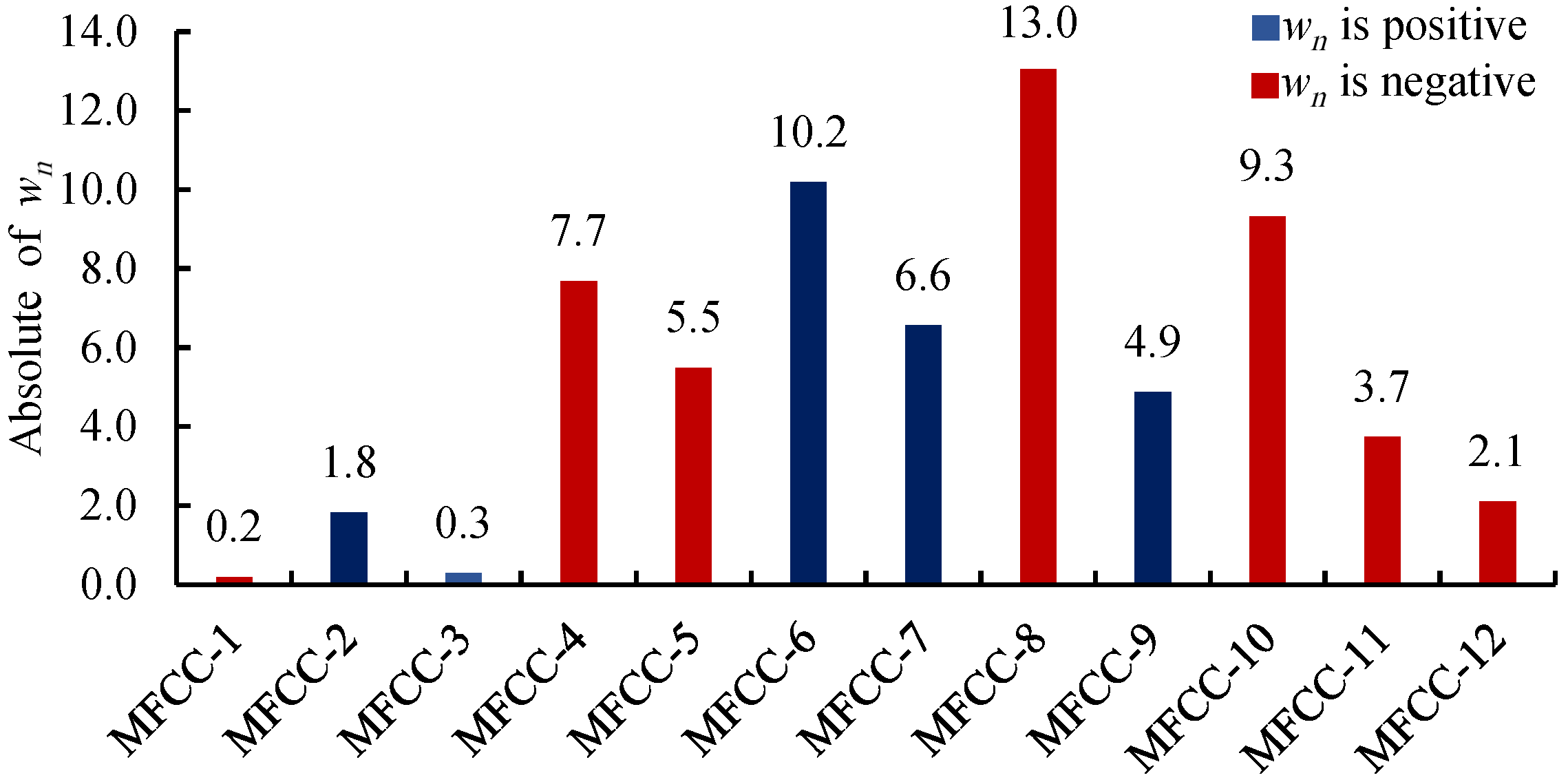
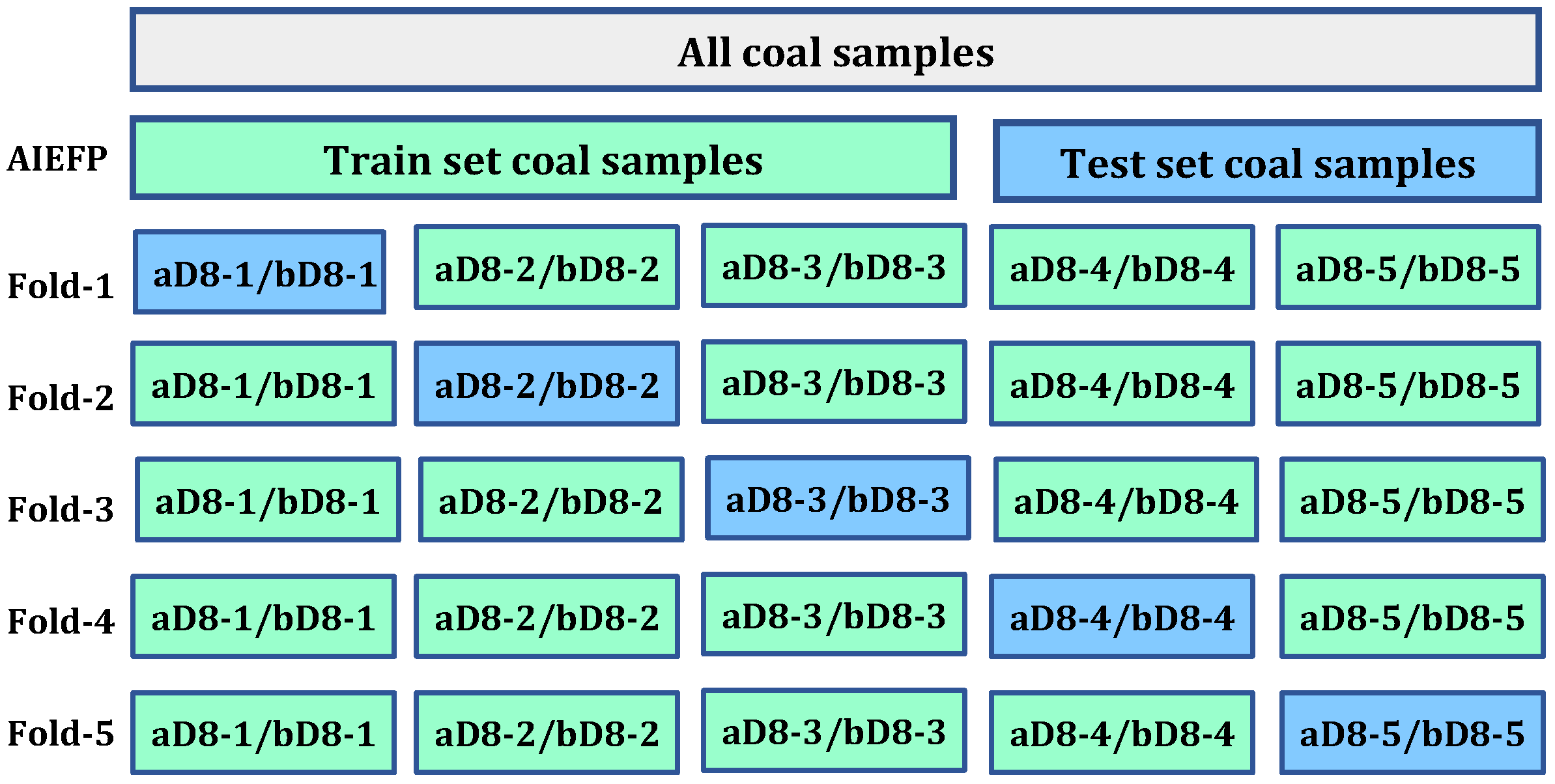



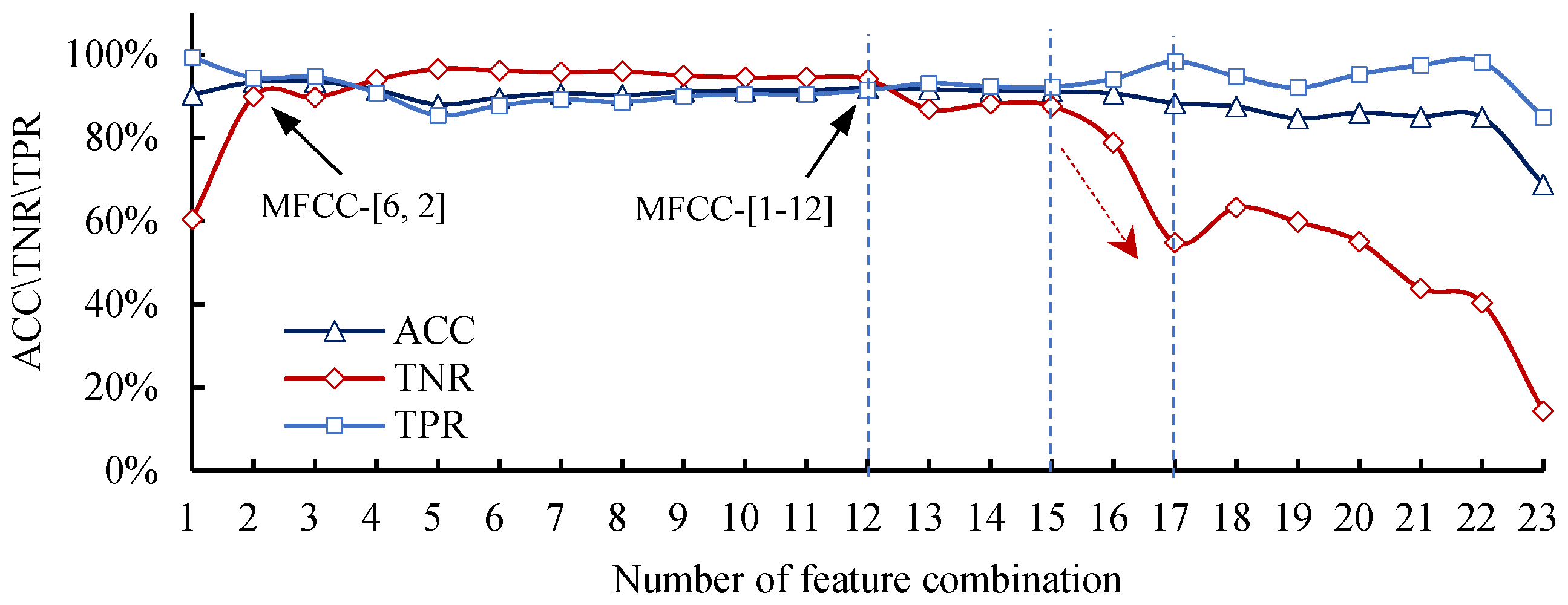


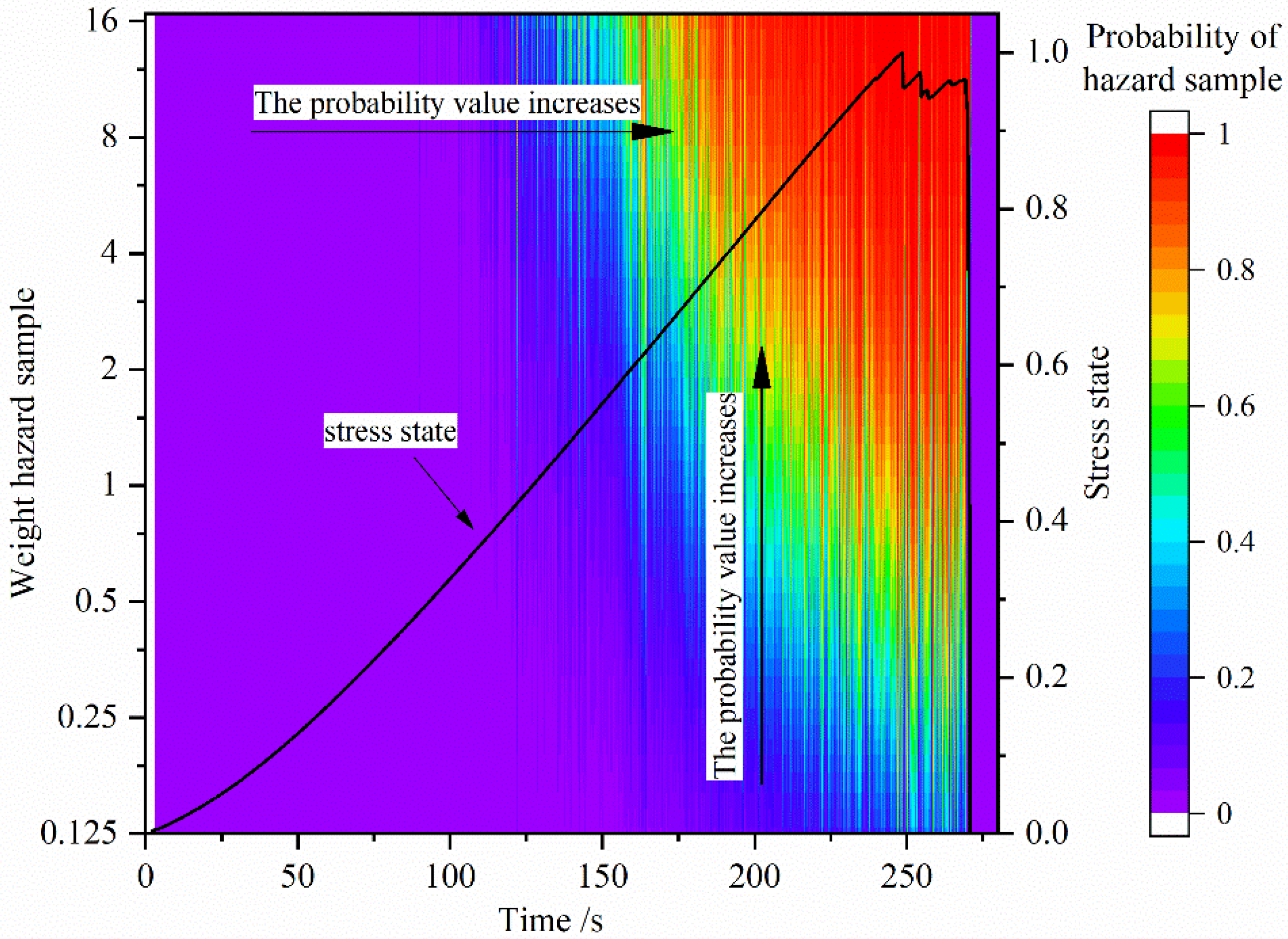
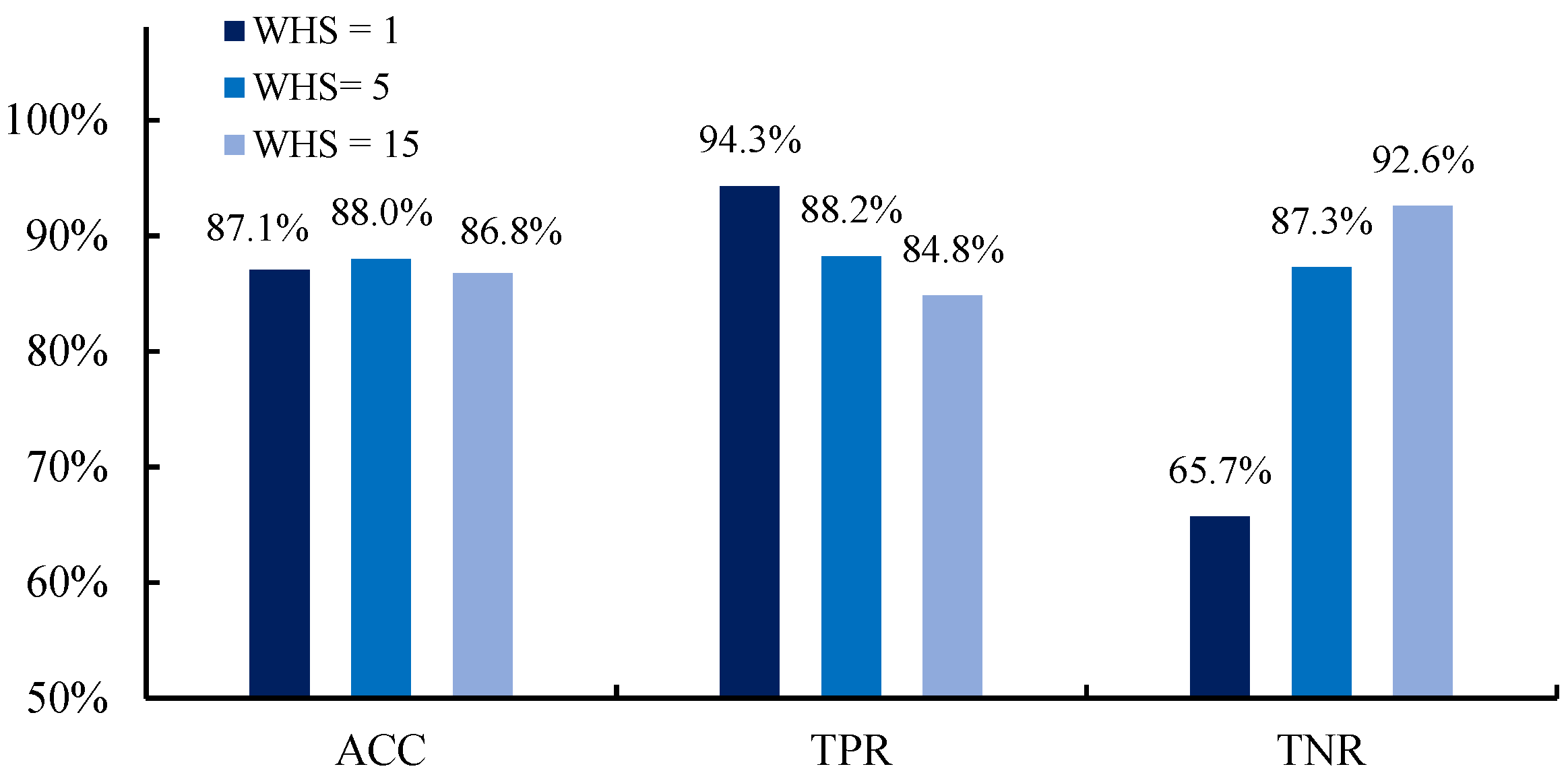
| Actual Situation | Predicted Result | |
|---|---|---|
| Positive | Negative | |
| Positive | TP | FN |
| Negative | FP | TN |
| Coal Mine | Sample | Length/mm | Width/mm | Height/mm | Strength/MPa | Load Rate |
|---|---|---|---|---|---|---|
| Dongqu mine | aD8-1 | 50.5 | 50.4 | 100.6 | 8.56 | 0.005 mm/s |
| aD8-2 | 50.1 | 50.4 | 95.9 | 14.78 | 0.005 mm/s | |
| aD8-3 | 52.1 | 52.6 | 99.7 | 10.18 | 0.005 mm/s | |
| aD8-4 | 50.7 | 51 | 97.7 | 14.35 | 0.005 mm/s | |
| aD8-5 | 50.8 | 50.6 | 100.4 | 12.67 | 0.005 mm/s | |
| bD8-1 | 54.3 | 51.1 | 100.6 | 8.36 | 0.50 kN/s | |
| bD8-2 | 50.1 | 50.4 | 95.9 | 13.17 | 0.50 kN/s | |
| bD8-3 | 49.2 | 51.2 | 99.8 | 11.50 | 0.50 kN/s | |
| bD8-4 | 52.2 | 52 | 100.3 | 12.95 | 0.50 kN/s | |
| bD8-5 | 52.5 | 51.6 | 100.1 | 19.02 | 0.50 kN/s |
| Coal Specimen | AE Segments | Coal Specimen | AE Segments | ||||
|---|---|---|---|---|---|---|---|
| Safe | Hazardous | Total | Safe | Hazardous | Total | ||
| aD8-1 | 3128 | 1122 | 4250 | bD8-1 | 1510 | 440 | 1950 |
| aD8-2 | 3029 | 889 | 3918 | bD8-2 | 694 | 281 | 975 |
| aD8-3 | 3526 | 874 | 4400 | bD8-3 | 388 | 587 | 975 |
| aD8-4 | 6681 | 1494 | 8175 | bD8-4 | 1366 | 434 | 1800 |
| aD8-5 | 5319 | 1675 | 3994 | bD8-5 | 2306 | 593 | 2899 |
| Fold | TP | FN | FP | TN | ACC | TNR | TPR |
|---|---|---|---|---|---|---|---|
| Fold-1 | 3546 | 177 | 367 | 803 | 88.9% | 68.6% | 95.2% |
| Fold-2 | 3331 | 583 | 219 | 1248 | 85.2% | 85.4% | 85.1% |
| Fold-3 | 7060 | 987 | 471 | 1457 | 85.4% | 75.6% | 87.7% |
| Fold-4 | 4372 | 266 | 536 | 1026 | 87.1% | 65.7% | 94.3% |
| Fold-5 | 9671 | 654 | 135 | 2133 | 92.0% | 94.0% | 91.4% |
| Number of Feature Combination | MFCC Combine | Number of Feature Combination | MFCC Combine |
|---|---|---|---|
| 1 | MFCC-[6] | 13 | MFCC-[2,1,10,4,8,5,7,9,11,3,12] |
| 2 | MFCC-[6,2] | 14 | MFCC-[1,10,4,8,5,7,9,11,3,12] |
| 3 | MFCC-[6,2,1] | 15 | MFCC-[10,4,8,5,7,9,11,3,12] |
| 4 | MFCC-[6,2,1,10] | 16 | MFCC-[4,8,5,7,9,11,3,12] |
| 5 | MFCC-[6,2,1,10,4] | 17 | MFCC-[8,5,7,9,11,3,12] |
| 6 | MFCC-[6,2,1,10,4,8] | 18 | MFCC-[5,7,9,11,3,12] |
| 7 | MFCC-[6,2,1,10,4,8,5] | 19 | MFCC-[7,9,11,3,12] |
| 8 | MFCC-[6,2,1,10,4,8,5,7] | 20 | MFCC-[9,11,3,12] |
| 9 | MFCC-[6,2,1,10,4,8,5,7,9] | 21 | MFCC-[11,3,12] |
| 10 | MFCC-[6,2,1,10,4,8,5,7,9,11] | 22 | MFCC-[3,12] |
| 11 | MFCC-[6,2,1,10,4,8,5,7,9,11,3] | 23 | MFCC-[12] |
| 12 | MFCC-[6,2,1,10,4,8,5,7,9,11,3,12] | 24 |
Publisher’s Note: MDPI stays neutral with regard to jurisdictional claims in published maps and institutional affiliations. |
© 2022 by the authors. Licensee MDPI, Basel, Switzerland. This article is an open access article distributed under the terms and conditions of the Creative Commons Attribution (CC BY) license (https://creativecommons.org/licenses/by/4.0/).
Share and Cite
Wang, H.; Li, Z.; Song, D.; He, X.; Khan, M. Applying Machine Learning and Automatic Speech Recognition for Intelligent Evaluation of Coal Failure Probability under Uniaxial Compression. Minerals 2022, 12, 1548. https://doi.org/10.3390/min12121548
Wang H, Li Z, Song D, He X, Khan M. Applying Machine Learning and Automatic Speech Recognition for Intelligent Evaluation of Coal Failure Probability under Uniaxial Compression. Minerals. 2022; 12(12):1548. https://doi.org/10.3390/min12121548
Chicago/Turabian StyleWang, Honglei, Zhenlei Li, Dazhao Song, Xueqiu He, and Majid Khan. 2022. "Applying Machine Learning and Automatic Speech Recognition for Intelligent Evaluation of Coal Failure Probability under Uniaxial Compression" Minerals 12, no. 12: 1548. https://doi.org/10.3390/min12121548







